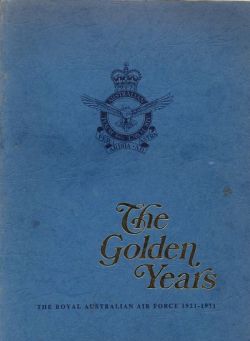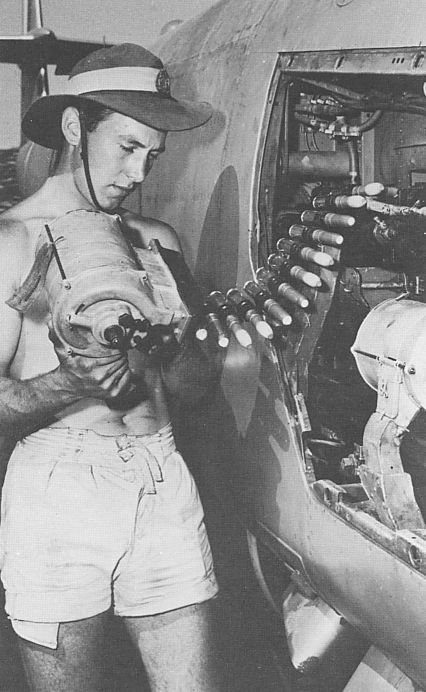
RAAF
RAAF in Korea

In 1971 the Australian Government published a book celebrating the RAAF's 50th birthday, from which I reproduce here the Korean War information.
Iwakuni

First Action for 77 Squadron

A last minute briefing to pilots of No. 77 Squadron from their commanding officer, Squadron Leader R. C. Cresswell, before take off from a base in Korea on an operational mission. On this particular mission the RAAF Meteor pilots were assigned as escort to United States Air Force Shooting Stars on a photographic sortie.
A formation of RAAF Meteor jets of No. 77 Squadron in flight over Korea. Under the wing of the nearest jet can be seen the rails for the high explosive rockets which the Squadron used with deadly accuracy against enemy troops and installations.
Bruce Gogerly shot down a MiG-15 while flying his Meteor.

Flight Lieutenant Bruce Gogerly, of Westmead, New South Wales, who achieved the distinction of shooting down a superior-performance Russian built MiG while serving with No. 77 Squadron in Korea. Flight Lieutenant Gogerly completed a tour of duty with the Squadron, then returned at a later date to serve at a USAF radar site. Even though this was a ground job he kept his hand in by flying with the Squadron when he had a day off from official duties.
Despite the official verdict that Meteors were no match for MiG-15s, several 77 Squadron Meteor pilots managed to get kills against the superior aircraft.

An artist's impression of Meteors of No. 77 Squadron carrying out a bombing and strafing run against Communist positions in Korea.
The Squadron originally went to Korea equipped with Mustangs, but later were withdrawn to Japan to convert to jets before once more taking over an attacking role against Communist ground positions.
Pohang
In a desperate struggle, the Pusan perimeter in the south-east corner of the Korean Peninsula held and following General MacArthur's successful counter blows at Inchon and Wonsan, No. 77 Squadron moved from its base at Iwakuni to a bare airfield at Pohang on the east coast of Korea from which they supported the drive northwards across the 38th parallel.
RAAF armourer AC 1 Keith Inglis, of Wentworthville, Sydney.

A high explosive rocket used by No. 77 Squadron for their attacks against Communist ground positions in Korea.
Holding the rocket is RAAF armourer AC 1 Keith Inglis, of Wentworthville, Sydney.
POW
Former prisoners of war in North Korea, these two RAAF pilots were all smiles when they received new uniforms at the RAAF base at Kimpo soon after their release.

Flight Lieutenant Gordon Harvey, D.F.C. (left) pins a new set of wings on the uniform of Flying Officer Ron Guthrie. Harvey, now a Group Captain, escaped from his prison camp once, but was recaptured when he was almost in sight of freedom.
Altogether four RAAF pilots were taken prisoner during the Korean W ar.
Hamhung
Kimpo
Note: Despite this official verdict that Meteors were no match for MiG-15s, Pilot Officer Bill Simmonds (left) and Pilot Officer John Surman managed to get two kills.
MiG Killers

MiG killers: Pilot Officer Bill Simmonds (left) and Pilot Officer John Surman exchange mutual congratulations on their successes against superior performance Russian-built MiG 15 aircraft over North Kore
Both were serving in No. 77 Squadron, operating Gloster Meteor jets. Pilot Officer Surman, of Burwood, Sydney, claimed a probable when he and another Squadron pilot were jumped by two MiGs from a flight of nine.
Pilot Officer Simmonds from Bunbury, West Australia, had his kill confirmed when he was providing cover for American fighter bombers blasting targets near Pyongyang.
Nurses

A RAAF nursing sister offers a litter patient some reading material during an air ambulance flight from Korea to Iwakuni, in Japan, during the Korean war.
RAAF aircraft flew hundreds of wounded and sick from the war theatre to Japan throughout the conflict.
Armourers

Hard-hitting 20mm cannon shells being loaded into the weapons. system of a RAAF Meteor jet at Kimpo during the Korean war.
The armourer is LAC P. O'Toole, of Strathmore, Melbourne, serving with No. 77 Squadron.
Results

The end of another successful mission over enemy lines during the Korean war, and this Meteor jet of No. 77 Squadron is marshalled back into its revetment for refuelling and rearming, ready to scramble at short notice.
